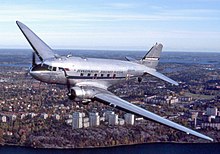Lovettsville air disaster
 A DC-3 similar to the accident aircraft | |
| Accident | |
|---|---|
| Date | August 31, 1940 |
| Summary | Lightning strike (probable) |
| Site | near Short Hill Mountain, Lovettsville, Virginia 39°16′24″N 77°41′05″W / 39.27333°N 77.68472°W |
| Aircraft type | Douglas DC-3 |
| Operator | Pennsylvania Central Airlines |
| Registration | NC21789 |
| Flight origin | Washington, D.C. |
| Stopover | Pittsburgh, Pennsylvania |
| Destination | Detroit, Michigan |
| Passengers | 21 |
| Crew | 4 |
| Fatalities | 25 |
| Survivors | 0 |
The Lovettsville air disaster occurred on August 31, 1940 near Lovettsville, Virginia. Pennsylvania Central Airlines Trip 19, a new Douglas DC-3A, was flying from Washington, D.C. to Detroit with a stopover in Pittsburgh. While the aircraft was flying at 6,000 feet (1,800 m) and approaching the West Virginia border, Trip 19 encountered an intense thunderstorm. Numerous witnesses reported seeing a large flash of lightning shortly before it nosed over and plunged to earth in an alfalfa field. With limited accident investigation tools at the time, it was at first believed that the most likely cause was the plane flying into windshear, but the Civil Aeronautics Board report concluded that the probable cause was a lightning strike.[1][2] U.S. Senator Ernest Lundeen from Minnesota was one of the 25 people (21 passengers and 4 crew members) killed.[3][4][5]
The crash occurred during a severe rainstorm, and recovery efforts were hindered by impassable flooded roads and poor communications: the crash cut the only telephone lines in the area. Wreckage was scattered over a broad area and it is believed that all aircraft occupants died instantly on impact. At the time, the crash was the deadliest disaster in the history of U.S. commercial aviation.[6]
"Trip 19", as it was designated, was under the command of Captain Lowell V. Scroggins with First Officer J. Paul Moore. The pilot and copilot had over eleven thousand and six thousand hours experience respectively, although only a few hundred of those hours were on DC-3s. In the jump seat rode a new administrative employee of the airline, hired on August 26.[1]
The DC-3A was newly delivered from Douglas Aircraft on May 25, 1940, equipped with twin Curtiss-Wright R-1820 Cyclone 9 engines (also designated as G-102-A).[1]
The CAB investigation of the accident was the first major investigation to be conducted under the Bureau of Air Commerce act of 1938.[1]
References
- ^ a b c d "Report of the Civil Aeronautics Board" (PDF). Civil Aeronautics Board. Archived from the original on 2014-09-15. Retrieved 2009-04-15.
{{cite web}}: CS1 maint: bot: original URL status unknown (link) - ^ "Causes of U.S. accidents" (PDF). Flight. December 19, 1940. p. 529.
- ^ "Death in the Blue Ridge". Time. 1940-09-09. Retrieved 2009-04-14.
The news of the worst crash in the history of U. S. aviation ended 17 months of safe operation.
- ^ "Accident Details". planecrashinfo.com. Retrieved July 5, 2017.
- ^ Beitler, Stu. "Lovettsville, VA Air Disaster, Aug 1940". gendisasters.com. Retrieved July 5, 2017.
- ^ "25 Killed as Airliner Crashes, Explodes in Worst Disaster of Aviation History". The Dallas Morning News. Dallas, Texas. Associated Press. September 1, 1940. Retrieved November 5, 2019.
- Airliner accidents and incidents caused by weather
- Airliner accidents and incidents in Virginia
- Aviation accidents and incidents in the United States in 1940
- Accidents and incidents involving the Douglas DC-3
- Loudoun County, Virginia
- 1940 in Virginia
- Capital Airlines (United States) accidents and incidents
- 1940 meteorology
- August 1940 events
